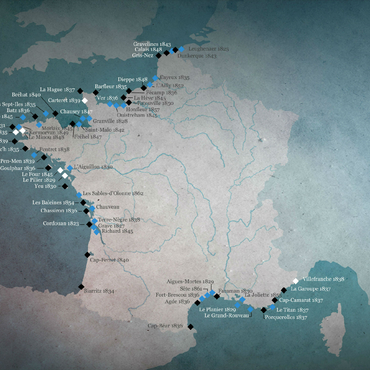
- Home
- Fresnel’s laboratory
- Lighthouses become a national project
- The 1825 coastal lighting plan
On 9 September 1825, The Lighthouse Commission adopted a report on a system for lighting the coasts of France presented by rear admiral and hydrographer Paul-Édouard de Rossel. The report, which summarised the experiements of Fresnel and the lighting plans put forward under the Ancien Régime, was the keystone of France's nineteenth-century maritime lighting policy. France embarked upon a utopian project: the creation of a network of lights that would allow sailors to navigate the country's coastlines without ever losing sight of a lighthouse. To do so involved construction and renovation efforts at some fifty sites, as well as increasing the range of their lights (some twenty nautical miles for the highest-powered lights). Historian Jules Michelet wrote that France, "armed with Fresnel's beam", had brought down "an additional heaven" to guide sailors. The network of lighthouses was an accomplished and intelligible celestial system, a metaphor that borrowed both its vocabulary and its concept from astronomy. Lighthouses were classified as stars, belonging to the first, second or third order, depending how vital they were to navigation. The nature of the light, i.e. its individual signal, was also inspired by astronomical nomenclature: a light was either fixed or eclipsed. When the report was published, only Cordouan had been fitted with a Fresnel lens, which would serve as the prototype for the Commission's new system.
